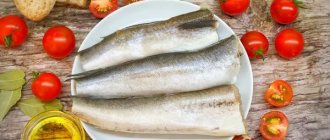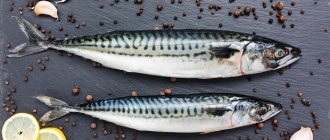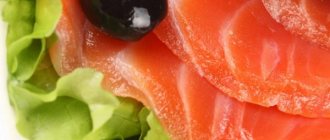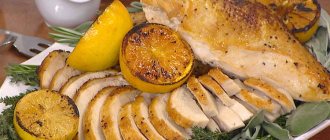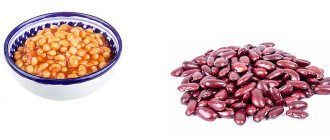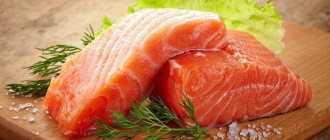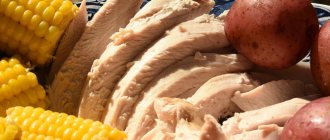The reason for the popularity of this fish was its geographical distribution. It lives in almost all seas. Thanks to this, its price is affordable for the common man. Fish is versatile in cooking. It turns out great baked, boiled, smoked, etc. Mackerel has a fairly high calorie content per 100 grams, but is nevertheless considered a conditionally dietary dish.
Chemical composition
The chemical composition of mackerel contains a huge amount of substances vital for the human body. The benefits of this fish are ensured by the fact that it contains the following elements:
- vitamins of group B, A, C;
- selenium;
- calcium;
- sodium;
- magnesium;
- fluorine;
- nickel;
- iodine;
- molybdenum;
- cobalt;
- phosphorus;
- iron;
- potassium;
- zinc;
- copper;
- manganese.
It is important to note that by consuming just 100 grams of this fish during the day, you can ensure that your body is full:
- selenium – 93.8% of the daily value;
- phosphorus – by 39.7% of the daily norm;
- vitamin B12 – 791.7% of the daily requirement.
The nutritional value of 100 grams of mackerel is:
- 18 grams of protein;
- 13.2 grams fat;
- 0 grams of carbohydrates;
- 0 grams of dietary fiber;
- 67.5 grams of water.
Mackerel in dietary nutrition
If you are on a diet or simply watch your figure and health, then you need to know that fish is indispensable for dietary nutrition, as it is a source of nutrients, vitamins and minerals. The average calorie content of mackerel allows you to consume it in moderation, even if you have problems with excess weight. In this case, the main role is played by the method of its preparation.
Nutritionists recommend consuming boiled, baked, convection-fried or steamed fish in small quantities, because it does not contain added fats other than its own. In addition to the optimal calorie content of mackerel, this fish retains more useful substances and contains a lot of valuable Omega-3 fatty acids.
When eating on a diet, you should not eat smoked or fried mackerel: it contains a lot of excess fat and harmful substances, which not only affect your figure, but also your overall health.
Benefits of mackerel
This fish is enriched with Omega-3 acid, which can improve immunity and improve metabolism. Therefore, mackerel should be a mandatory product in the diet of children, people suffering from cardiovascular diseases, pregnant and lactating girls.

The protein contained in mackerel is absorbed three times faster than, for example, beef. It is also important that just 100 grams of mackerel contains half of the daily requirement for the average person.
When consuming mackerel, the level of oxygen in the cells increases, due to which all internal organs are enriched with it, and the fish also helps to launch regeneration processes in the mucous membranes and skin.
Fish oil allows you to dilate the blood vessels of the heart muscle, thereby reducing the risk of blood clots. With regular use, bones and teeth are strengthened and immunity is increased.
All the substances found in fish help ensure the normal functioning of cells, overcome harmful bacteria and establish the water-salt balance in the body. It is important that this fish does not need to be consumed in large quantities; you just need to introduce several servings of stewed or boiled mackerel into your weekly diet, and the benefits for the body will be noticeable after a few weeks.
Useful tips
To properly salt a fish carcass, it is recommended to use useful culinary tips:
- the weight of the fish should be at least 300 g, since when salted it loses a lot of moisture, and too small and low-fat seafood will end up very dry;
- To preserve the taste and nutrients, the product must be marinated only in glass, plastic or enamel containers;
- Before pouring, the brine must be cooled to room temperature, otherwise the fish will simply cook;
- a fresh fish carcass should have a pleasant smell, a grayish tint with characteristic stripes and an elastic shape;

- When making marinade, it is not recommended to use iodized salt, since it will make the fish loose;
- with dry freezing, a day will be enough to make lightly salted fish; for a saltier product, it is necessary to keep the ingredient in the marinade for up to 2 days;
- Table vinegar will help reduce salting time;
- salting and storing fish is required only in the refrigerator compartment or other cold place;
- When purchasing a frozen product, it is recommended to pay attention to inspecting the ice crust: it should be free of yellowness, dark spots, cracks and sagging, and it must be uniform and transparent;
- after defrosting, a fresh fish carcass should retain its elasticity, and the bones should not move away from the fillet;
- Salted mackerel cannot be frozen, because after defrosting the meat will become very soft and watery;
- To make it easier to determine the degree of freshness of seafood, it is recommended to purchase fish only whole with entrails and head.
If you need to marinate fish at home in the shortest possible time, it is recommended to use a recipe that includes fish fillet or pieces of mackerel, since the whole carcass will require from 2 to 3 days for spicy salting.
Calorie content of fish
During the cooking process, the calorie content of the product depends on the type of heat treatment. The table below will show in detail what the calorie content of mackerel will be per 100 grams in boiled, fried, stewed and other types of preparation.
| Cooking method | Calorie content per 100 g (kcal) | Proteins (g) | Fat (g) | Carbohydrates (g) |
| Baked mackerel (no oil) | 181,0 | 18,7 | 11,9 | 0 |
| Baked mackerel in foil with tomatoes (no oil) | 167,0 | 17,0 | 10,8 | 0,4 |
| Fried mackerel (in oil) | 278,0 | 13,1 | 25,1 | 0 |
| Stewed mackerel in sour cream with onions and carrots | 139,0 | 11,2 | 10,0 | 1,2 |
| Cold smoked mackerel | 151,0 | 23,2 | 6,5 | 0 |
| Hot smoked mackerel | 248,6 | 21,0 | 17,8 | 1,5 |
| Boiled mackerel | 194,5 | 18,8 | 13,4 | 0 |
| Lightly salted mackerel | 196,4 | 21,2 | 13,3 | 0,1 |
| Dried mackerel | 152,8 | 25,2 | 4,5 | 0,9 |
| Grilled mackerel | 178,7 | 19,1 | 11,9 | 0,1 |
| Marinated mackerel | 135,3 | 11,9 | 8,5 | 3,5 |
Once you know the calorie content of mackerel per 100 grams, you can easily understand in what form this fish is most nutritious. From the presented data it is clear that hot smoked mackerel will have the most calories. But from eating this fish in stewed or pickled form, the body will receive fewer calories.
Having understood what nutritional value mackerel provides the body and what health benefits it can bring, you can begin to consider the simplest and most delicious recipes.
How to tasty and quickly salt fish in the freezer without brine at home?
Salting in the freezer is increasingly gaining popularity. To enjoy ready-made fish, you need to wait a day. There is no need to make brine; everything is done dry. But the mackerel is not completely coated with salt, but is cut in a certain way.
Ingredients:
- mackerel - 2 pcs.
- ground sweet paprika - 1 tsp.
- garlic - 3 cloves
- salt - 2 tbsp.
- ground black pepper - 1 tsp.
- bay leaf - 6 pcs.
How to cook:
1. Gut the fish, cut off the head and fins. Make a cut along the ridge from the inside to the tail. Do not cut all the way deep; let the skin on the back remain intact.
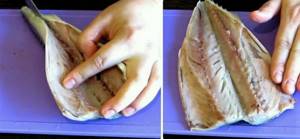
2. You will get something like a book, from which you need to take out (cut out) the ridge. If you wish, you can use tweezers to pick out the rib bones and fillet them, but this is not necessary.
3.Cut the garlic into medium pieces with a knife. No need to grind.

4. Place the prepared carcasses on a cutting board and sprinkle each with salt on all sides (including the skin side). For one mackerel, take a level tablespoon of salt.
5.Place pieces of garlic inside each fish. Also sprinkle with paprika and ground black pepper (half a teaspoon per carcass).
6. Arrange whole bay leaves. There is no need to break them, because then it will be difficult to get them out of there.
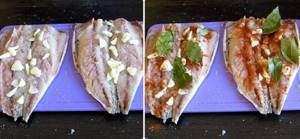
7.When all the spices have been added, close the carcass and put it in a bag, wrap it tightly. Or wrap in cling film. Tighten the bag with rubber bands so that the fish lies there tightly.
8.Place the mackerel in a bag in the freezer for a day.

9.Well, that's the whole recipe. When the fish is ready, remove the garlic and bay leaves. Cut into pieces and place on a plate. It’s delicious to eat this pickle with pickled onions, fresh herbs and, of course, potatoes.
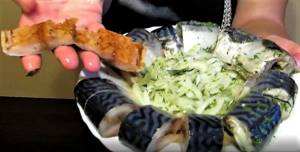
Fried mackerel in vegetable oil: a simple recipe
First you need to prepare the fish. Fresh mackerel should be cleaned and washed in water.
Next, the fish is cut into equal pieces and breaded in flour with the addition of a small amount of salt. Pour a little vegetable oil into a heated frying pan (you can use either sunflower or olive oil). Next, the fish is placed in a frying pan and fried on both sides. You can serve fried mackerel with any favorite side dish.
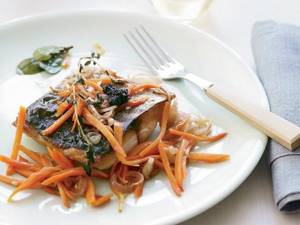
Salted mackerel: calorie content and product quality
Salted mackerel is a fairly popular fish appetizer. Some people put lightly salted herring in first place, while others cannot imagine a spiritual feast without spicy salted mackerel. Unlike other types of marine fish, mackerel has fatty, fleshy flesh, which allows you to fully enjoy the excellent taste.
The calorie content of salted mackerel should not differ much from the calorie content of fresh fish. As you know, salt and water do not contain calories, so salted mackerel is not a high-calorie product. However, this is only relevant for mackerel salted according to a standard recipe (the brine includes only salt, water and spices). There are at least 3 types of brine in which fish are soaked. Depending on this, the calorie content of spicy-salted mackerel will be different:
- The calorie content of simple (standard) salted mackerel is 155-161 kcal/100 g;
- Mackerel soaked in brine with added sugar – 175-183 kcal/100 g;
- The calorie content of mackerel salted in a solution with the addition of sugar and vegetable oil is 190-222 kcal/100 g.
Stewed mackerel in sour cream: recipe
Using this recipe for stewed mackerel, quickly and deliciously cooked in the oven, you can feed your household. At the same time, this dish will not only help saturate the body and satisfy hunger, but will also bring benefits.
First you need to prepare the ingredients, namely:
- mackerel - 1 pc.;
- potatoes – 500 g;
- carrots – 100 g;
- onions – 2 pcs.;
- tomatoes – 2 pcs.;
- sour cream (15% fat) – 100 g;
- herbs, salt, vegetable oil, spices - to taste.
The mackerel is cleaned and cut into small pieces. Vegetables should also be peeled, washed thoroughly under water and cut. Next, you need to lay out the ingredients in layers in a fireproof form, greased with vegetable oil:
- 1st layer - potatoes;
- 2nd layer – fish;
- 3rd layer – onions and carrots;
- 4th layer – tomatoes;
- 5th layer – greens.
Each layer needs a little salt. Then add sour cream to the pan and place it in the oven for 30 minutes. Cooking mackerel in the oven is quick and tasty. The dish can be served without additional side dish.

Tender spicy salted mackerel pieces - a very successful recipe
This is a very simple recipe. This is how I most often salt fish. Whether it's herring or mackerel. I salt it in the evening, and after a day you can serve this tender fish for dinner. The amount of spices can be adjusted as desired. The main thing is the presence of salt and sugar. You don’t have to use spices at all if you don’t like additional flavors in pickling.
If you salt the whole mackerel, it will take more time to cook it - at least 3 days. Although it is believed that cooking in pieces will lose some of the fat, I really like the result.
Read the recipe for salting whole fish with the head in this article below (see contents).
Ingredients:
- mackerel - 2 pcs. average
- salt - 3 tbsp.
- sugar - 2 tbsp.
- black peppercorns - 20 pcs.
- allspice peas - 10 pcs.
- bay leaf - 5 pcs.
- cloves - 5 pcs.
- water - 1 l
Cooking method:
1.First you need to cook the brine. A liter of water will be enough for two fish. Pour water into a saucepan or other heat-resistant container and boil it. Add 3 tablespoons salt and 2 tablespoons sugar.
2.Also add all the prepared spices. Boil the marinade for about 3 minutes until all the crystals are completely dissolved and the spices are released.
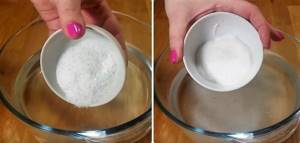
In cold water, spices will not give any flavor and will be of no use. Therefore, you need to boil it a little. If you take only salt and sugar, then they can be dissolved in cooled boiled water.
3. Cool the brine (brine) to room temperature. You can’t pour the fish hot, otherwise you’ll just boil the mackerel instead of salting it.
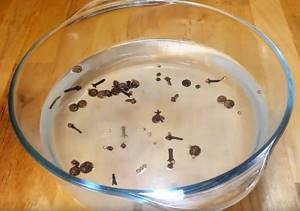
4. Cut off the head of the thawed carcass and remove the entrails. Scrub thoroughly in the middle so that no black films remain. Rinse well under running water.
5.Cut the fish into portions about 2 cm thick. Place them in a bowl where they will be salted. Take containers made of food-grade plastic, glass or enamel.

6.Pour the cooled marinade over the mackerel and cover with a lid. If there is no lid, cover it with film. Place in the refrigerator for 24 hours. In a day, such a preparation will be lightly salted. The longer it is stored in the marinade, the more salt it will accumulate.
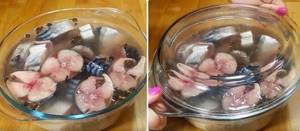
The pieces should be completely covered with water. You can put a saucer on top to prevent them from floating up.
7.That’s it, take out the finished, salted fish and serve it with onions. To taste, you can add a little vinegar or lemon juice or vegetable oil. Boiled potatoes are ideal as a side dish. This is delicious.
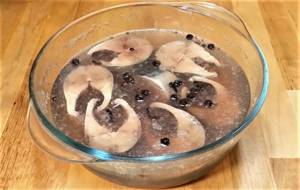
Finished mackerel should not have red blood marks near the ridge inside. If it’s still reddish, don’t eat it, but let it sit in the brine.

Calorie content of lightly salted mackerel is 160 kcal per 100 g. product.
Cooking mackerel in a slow cooker: recipe
Having a multicooker makes preparing any dish much easier. In the case of this fish, you should first pour a little water into the bottom of the bowl. Next, you need to clean the fish, cut it and salt it. Cover a special container for steaming with food foil and place the mackerel in it. Next, put a little onion, cut into half rings, and a few slices of lemon on top of the fish.
Cook the fish in the “Steam” mode for 25-30 minutes. This fish will be useful for both children and adults.
Dry method of salting whole mackerel with head
To dry-salt fish, you don’t need many ingredients. The main thing is the presence of salt. You will have to wait 5 days until it is completely salted. So what should you do?
Ingredients:
- fish
- salt
Preparation:
1. Thaw the mackerel and wash it. There is no need to gut it, leave the carcass whole.
2. Stuff plenty of salt into the gills on both sides.
3.Take a convenient container of a suitable size and cover it with a bag. Add salt until it completely covers the bottom. Place the carcass on a salt bed and cover with salt on all sides.

Each fish should be covered with a thick layer of salt. You can add a tablespoon of vodka for reliability and a tablespoon of sugar for each carcass for taste.
4. Wrap the bag on top and leave at room temperature for a couple of hours, and then put it in the refrigerator for 5 days.
5.After two days, remove and turn over the fish. Wrap it again and refrigerate.
6.After 5 days, clean the salt layer and soak the fish in clean water for 3-4 hours. During this time, the water can be changed once or twice.
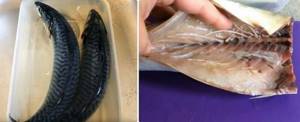
7.Remove the mackerel from the water; it will be ready to eat. Now you can cut off everything unnecessary, remove the insides and rinse. If you want to dry the carcasses, put them in the refrigerator in an open container for one day. Such fish can be stored in the freezer for quite a long time, wrapped in cling film.
8.Fish according to this recipe turns out to be moderately salty, dense and tasty.
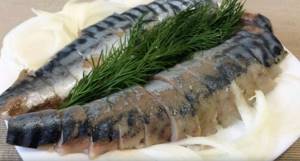
Harm to mackerel
For a healthy body, this fish cannot cause any harm. However, it should be remembered that if you have diseases such as kidney failure, hypertension, pancreatitis or cholecystitis, mackerel should not be consumed salted or smoked.
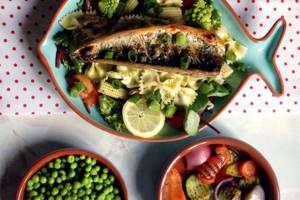
If you have problems with the gastrointestinal tract, you need to exclude this fish from your diet. In some cases, it is permissible to consume mackerel only in boiled form. However, it is worth remembering that high fat content can lead to unpleasant consequences. Therefore, you should discuss with your doctor the inclusion of this product in your diet.
Glycemic index
Due to its very low sugar (carbohydrate) content, mackerel occupies a leading position in the field of products with a low glycemic index, since this indicator is equal to 0 in this case. Even if certain methods of heat treatment contribute to the appearance of a small amount of carbohydrates in the fish, this does not become the reason. does not allow people with diabetes to consume mackerel. Indeed, there are a number of products that contain a low GI index and their consumption is quite acceptable (low index - from 10 to 50). These products include the following:
- greens – 5 units;
- cabbage – 10 units;
- chicken – 30 units;
- turkey breast – 50 units.
Important! It turns out that eating mackerel, regardless of the method of preparation, is a completely acceptable dish from this point of view.
What it is
Mackerel is a valuable, predatory sea fish. Weight approximately 300-400 grams , length 30-40 cm . Swims in large schools in many seas and oceans. The most delicious and healthy is the Atlantic one. This is what we eat. It is especially good in late autumn, when it accumulates a lot of fat. It comes to Russian shelves from the Far East. It is caught by fishermen of the Murmansk fleet in the Barents and North seas.

Contraindications
Compared to the number of beneficial properties of mackerel, it has almost no contraindications. These include only individual intolerance, allergic reactions, exacerbations of diseases of the heart and digestive system. If you have such ailments, you can eat fish, but you need to consult a doctor regarding the amount and type of preparation. People suffering from liver and kidney diseases should eat boiled, baked or lightly salted fish.
Mackerel can be harmful if consumed in too much quantity and if cooked incorrectly. The latter concerns hot smoked fish, of which there is so much on store shelves. When treated with “liquid smoke” and high smoking temperatures, toxic phenol is formed. The harm lies in the accumulation of mercury, carcinogens and chemical flavors in the product.
The nutritional value
Vitamins
- Choline 101.6 mg
- PP Vitamin PP (NE) 3.3 mg
- B12 Vitamin B12 12 mcg
- B9 Vitamin B9 15 mcg
- B6 Vitamin B6 0.41 mg
- B2 Vitamin B2 0.19 mg
- B1 Vitamin B1 0.02 mg
- K Vitamin K 7.8 mcg
- E (TE) Vitamin E (TE) 2.38 mg
- D Vitamin D 1006 mcg
- A (RE) Vitamin A (RE) 47 mcg
Macronutrients
- Zn Zinc 1.1 mg
- Se Selenium 73.4 mcg
- Cu Copper 0.1 mg
- Fe Iron 1.4 mg


